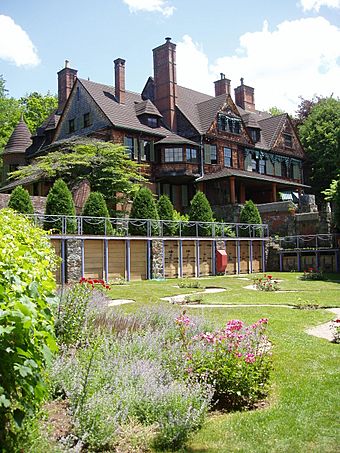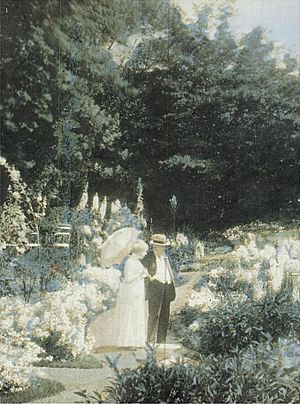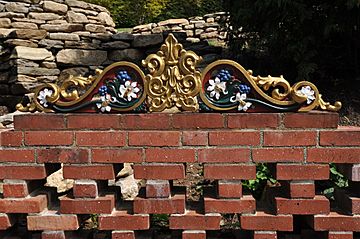Naumkeag facts for kids
|
Naumkeag
|
|
 |
|
| Location | 5 Prospect Hill Rd Stockbridge, Massachusetts |
|---|---|
| Built | 1886–87 |
| Architect | Stanford White; Landscape Architect: Fletcher Steele |
| Architectural style | Shingle Style |
| NRHP reference No. | 75000264 |
Quick facts for kids Significant dates |
|
| Added to NRHP | November 3, 1975 |
| Designated NHLD | March 29, 2007 |
Naumkeag is a stunning historic estate located in Stockbridge, Massachusetts. It was once the summer home of a very important lawyer from New York City, Joseph Hodges Choate, and his wife, Caroline. The main building is a large, 44-room country house. It was designed by a famous architect named Stanford White in the 1880s.
This estate is also famous for its amazing gardens. These gardens were created later by a well-known landscape designer, Fletcher Steele, with Joseph and Caroline's daughter, Mabel Choate. Today, Naumkeag is a special place. It is owned by The Trustees of Reservations and is open to the public as a museum. It's a great spot to learn about history and enjoy beautiful scenery!
Contents
Discovering Naumkeag's Grand House
Naumkeag was built in 1885 and 1886. It was designed by architect Stanford White for Joseph Hodges Choate. Joseph Choate was a very important lawyer in New York City. He also served as the American ambassador to the United Kingdom from 1899 to 1905. His wife, Caroline, was an artist and believed strongly in education for women.
The house is built in a style called the Shingle Style. This means it has a unique look with wooden shingles covering the outside. It also features brick and stone towers, big gables (the triangular parts of a roof), and a large porch. Inside, you can see beautiful wooden details. The house still holds the Choate family's furniture, Chinese porcelain (fancy dishes), and art. This art was collected from America, Europe, and even the Far East.
Exploring Naumkeag's Wonderful Gardens
The house sits on about 8 acres (3.2 hectares) of amazing terraced gardens. These gardens include special areas like The Rose Garden, The Afternoon Garden, and The Chinese Garden. The gardens are surrounded by 40 acres (16 hectares) of woods, meadows, and pastures.
The first garden designs were made in the late 1880s by Nathan Franklin Barrett. He created two terraces, and flower beds that are now part of the Chinese Garden. He also designed evergreen topiary, which are plants shaped into fun forms.
The Famous Blue Steps and Other Garden Designs
Later, between 1926 and 1956, the gardens were redesigned and expanded. This work was done by the famous landscape designer Fletcher Steele. He worked closely with Mabel Choate, Joseph and Caroline's daughter.
Fletcher Steele added many new features. These include the Afternoon Garden in 1926. One of his most famous designs, the incredible Blue Steps, was added in 1938. He also worked on the Chinese Garden between 1936 and 1955. These gardens are a fantastic example of landscape design from that time.
The History of Naumkeag Estate
The area where Naumkeag stands today was first settled in the 1730s. This was when Stockbridge began as a community for Native Americans. Joseph Hodges Choate bought the land for Naumkeag in 1884. His family had often vacationed in Stockbridge and loved to picnic on this very spot.
Joseph Choate was good friends with architect Charles Follen McKim. However, most of the design for the house was done by McKim's partner, Stanford White. The house was finished in 1886 and cost about $35,000. Stanford White also helped the Choates choose decorations and furniture for their new home. He even traveled to Europe with them to find special pieces.
Over the years, the house had some changes. For example, the library was made bigger in 1897. More bathrooms were added in the early 1900s. When Mabel Choate owned the estate, she made only small changes to the house.
Joseph Choate first asked Frederick Law Olmsted to design the landscape. But he didn't like Olmsted's idea to put the house halfway down the hill. So, the job went to Nathan Barrett instead. Barrett's garden plans were put into action between 1884 and 1894. He designed formal flower gardens near the house. He also created a wide meadow sloping down the hill, with an orchard. Choate also asked a sculptor, Frederick MacMonnies, to create a statue for the garden. The result was a sculpture called Young Faun with Heron.
Between 1895 and 1925, some small changes were made to the gardens. But after Joseph Choate passed away in 1917, his daughter Mabel took charge. Mabel Choate loved preserving things, gardening, traveling, and collecting art. She worked with designer Fletcher Steele starting in 1926.
When Mabel Choate passed away in 1958, she left Naumkeag to The Trustees of Reservations. She wanted the estate to be kept just as it was, showing how people lived in her time. Out of about 700 gardens designed by Fletcher Steele, Naumkeag is one of only two that still exist. It is the only one that is open to everyone to visit.
Naumkeag's main house was recognized as a special historic place in 1975. In 2007, the entire estate became a National Historic Landmark District. This means it's a very important place in American history. It's recognized for its well-preserved house and the amazing, creative garden designs by Fletcher Steele.
Image gallery
See also
 In Spanish: Naumkeag para niños
In Spanish: Naumkeag para niños







